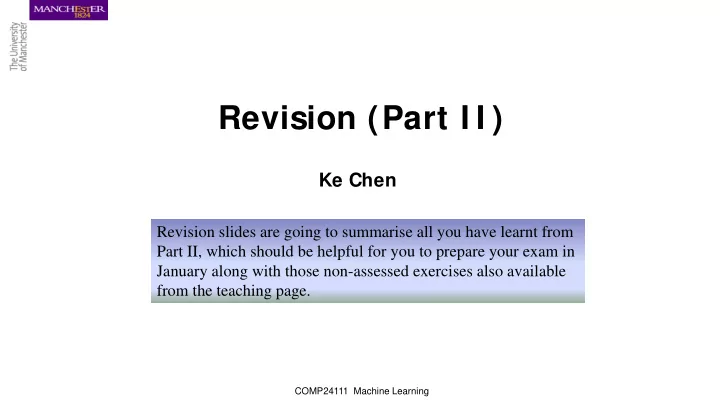

Revision (Part I I ) Ke Chen Revision slides are going to summarise all you have learnt from Part II, which should be helpful for you to prepare your exam in January along with those non-assessed exercises also available from the teaching page. COMP24111 Machine Learning
Generative Models and Naïve Bayes • Probabilistic Classifiers – discriminative vs. generative classifiers – Bayesian rule used to convert generative to discriminative, MAP for decision making • Naïve Bayesian Assumption – Conditionally independent assumption on input attributes • Naïve Bayes classification algorithm: discrete vs. continuous features – Estimate conditional probabilities for each attribute given a class label and prior probabilities for each class label (training phase) – MAP rule for decision making (test phase) • Relevant issues – Zero conditional probability due to short of training examples – Applicability to problems violating the naïve Bayes assumption COMP24111 Machine Learning 2
Clustering Analysis Basics • Clustering Analysis Task – discover the “natural” clustering number – properly grouping objects into “sensible” clusters • Data type and representation – Data type: continuous vs. discrete (binary, ranking, …) – Data matrix and distance matrix • Distance Metric – Minkowski distance (Manhattan, Euclidean …) for continuous – Cosine measure for nonmetric – Distance for binary: contingency table, symmetric vs. asymmetric • Major Clustering Approach – Partitioning, hierarchical, density-based, spectral, ensemble, … COMP24111 Machine Learning 3
K-Means Clustering • Principle – A typical partitioning clustering approach with an iterative process to minimise the square distance in each cluster • K-means algorithm 1) Initialisation: choose K centroids (seed points) 2) Assign each data object to the cluster whose centroid is nearest 3) Re-calculate the mean for each cluster to get a updated centroid 4) Repeat 2) and 3) until no new assignment • Application: K-means based image segmentation • Relevant issues – Efficiency: O( tkn ) where t, k < < n – Sensitive to initialisation and converge to local optimum – Other weakness and limitations COMP24111 Machine Learning 4
Hierarchical and Ensemble Clustering • Hierarchical clustering – Principle: partitioning data set sequentially – Strategy: divisive (top-down) vs. agglomerative (bottom-up) • Cluster Distance – Single-link, complete-link and averaging-link • Agglomerative algorithm 1) Convert object attributes to distance matrix 2) Repeat until number of cluster is one Merge two closest clusters o Update distance matrix with cluster distance o • Key concepts and technique in heretical clustering – Dendrogram tree, life-time of clusters, K life-time – Inferring the number of clusters with maximum K life-time • Clustering ensemble based on evidence accumulation – Multiple k-means clustering with different initialisation, resulting in different partitions; – Accumulating the “evidence” from all partitions to form a “collective distance” matrix; – Apply agglomerative algorithm to the “collective distances” and decide K using maximum K life-time COMP24111 Machine Learning 5
Cluster Validation • Cluster Validation – Evaluate the results of clustering in a quantitative and objective fashion – Performance evaluation, clustering comparison, find cluster num. • Two different types of cluster validation methods – Internal indexes • No ground truth available and sometimes named “relative index” • Defined based on “common sense” or “a priori knowledge” • Scatter-based validity indexes • Application: finding the “proper” number of clusters, … – External indexes • Ground truth known or reference given • Rand Index: understanding the idea in addressing the permutation/inconsistency issues • Application: performance evaluation of clustering, clustering comparison... – Weighted clustering ensemble • Key idea: using multiple “meaningful” validity indexes to weight different partitions before evidence accumulation to diminish the effect of trivial partitions COMP24111 Machine Learning 6
Examination I nformation • Three Sections (total 60 marks) – Section A (30 marks) o 30 multiple choice questions totally ( online ) o Q1-15 for Part I & Q16-30 for Part II – Section B (15 marks) o Compulsory questions relevant to Part I – Section C (15 marks) o Compulsory questions relevant to Part II • Length: two hours • Calculator (without memory) allowed COMP24111 Machine Learning 7
Recommend
More recommend